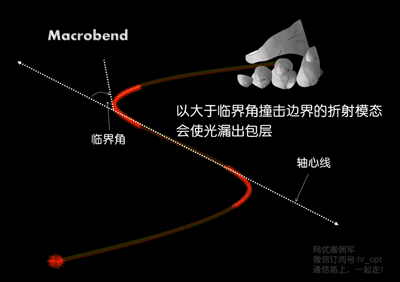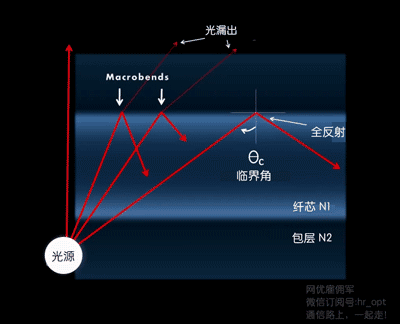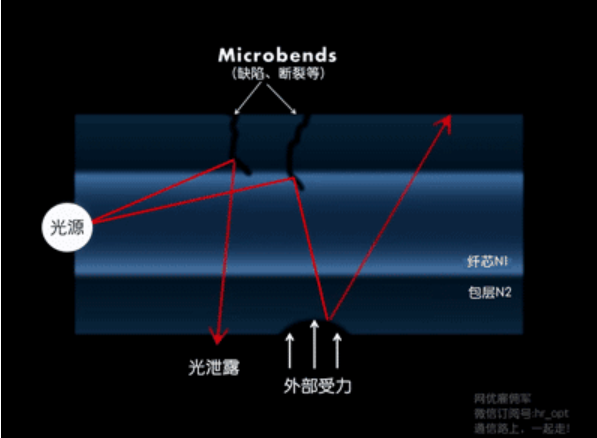When light is incident from one end of the fiber and emitted from the other end, the intensity of the light is weakened, which means that after the optical signal propagates through the fiber, the light energy is attenuated. This means that some substances in the fiber or for some reason block the passage of the light signal. This is the transmission loss of the fiber. Only by reducing the fiber loss can the optical signal be unobstructed.
The main factors causing fiber loss are: intrinsic, bending, extrusion, impurities, unevenness and docking, etc., where the fiber bending loss is mainly caused by man.
The fiber is very sensitive to bending, excessive bending = light overflow. If the bend is too large, most of the light will overflow from the coating. Single mode is more sensitive to bending loss than multimode.

Optical loss occurs when two types of fiber are bent: Macrobend and Microbend.
Macrobend, which means that the radius of curvature is much larger than the diameter of the fiber, and the fiber bend in the demo video is a macrobend.

When the macro bend is corrected, it can be recovered.

Microbending refers to the creation of micron-scale bends on the fiber axis, such as by over-tightening of the bundle.

In intrinsic loss, the scattering loss and absorption loss are determined by the properties of the fiber material, and the natural losses are different at different operating wavelengths. It is important to find out the mechanism of loss and quantitatively analyze the damage caused by various factors.
A. Absorption loss
The material used to make the fiber absorbs light energy. After absorbing light energy, the particles in the fiber material vibrate, heat and dissipate energy, resulting in absorption losses. We know that matter is made up of atoms, molecules, which are made up of nuclei and electrons that rotate around the nucleus in certain orbits.
B. Scattering loss
In the dark, you can see a beam of light by illuminating the flashlight into the air. Also seen is a thick beam of light from a nighttime aerial searchlight.
Rayleigh scattering is also found in the fiber, and the resulting light loss is called Rayleigh scattering loss. In view of the current level of fiber manufacturing technology, it can be said that Rayleigh scattering loss is inevitable. However, since the Rayleigh scattering loss is inversely proportional to the wavelength of the fourth power light, the effect of Rayleigh scattering loss can be greatly reduced when the fiber is operated in the long wavelength region.
C. Loss caused by imperfect structure of optical fiber
When there are bubbles in the fiber, impurities or thickness are not uniform, especially the non-smooth core-cladding interface, when the fiber is transmitted to these places, some light will scatter in all directions, causing loss. This loss can be overcome by improving the process of fabricating the fiber. Scattering causes light to illuminate in all directions, and some scattered light is reflected back in the opposite direction of fiber propagation, which can be received at the incident end of the fiber.

In recent years, optical fiber communication has been widely used in many fields. In order to achieve fiber-optic communication, an important issue is to reduce the loss of the fiber as much as possible. The so-called loss refers to the attenuation of each fiber. The length of the fiber directly affects the transmission distance or the distance between the relay stations. It is of great practical significance to understand and reduce the fiber loss. Optical Fiber Communication.



